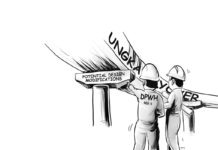[av_one_full first min_height=” vertical_alignment=” space=” custom_margin=” margin=’0px’ padding=’0px’ border=” border_color=” radius=’0px’ background_color=” src=” background_position=’top left’ background_repeat=’no-repeat’ animation=”]
[av_heading heading=’Updated lament on the sad state of Boracay ‘ tag=’h3′ style=’blockquote modern-quote’ size=’30’ subheading_active=’subheading_below’ subheading_size=’18’ padding=’10’ color=” custom_font=” av-medium-font-size-title=” av-small-font-size-title=” av-mini-font-size-title=” av-medium-font-size=” av-small-font-size=” av-mini-font-size=” admin_preview_bg=”]
BY HERBERT VEGO
[/av_heading]
[av_textblock size=” font_color=” color=” av-medium-font-size=” av-small-font-size=” av-mini-font-size=” admin_preview_bg=”]
February 13, 2018
[/av_textblock]
[av_textblock size=’18’ font_color=” color=” av-medium-font-size=” av-small-font-size=” av-mini-font-size=” admin_preview_bg=”]
IF PRESIDENT Rodrigo Duterte is no longer joking, then all businessmen who thrive in Boracay are in trouble because of his threat: “I will close Boracay.”
In six months’ time, unless the environmental problems are resolved, he would do it kuno. But of course, whether he would translate those words into action remains to be seen. Remember when he vowed to stop illegal drugs “within three to six months,” only to see more shabu coming in from China?
Anyway, Duterte made sense when he addressed a business forum in Davao City, “There will be a time that no more foreigner will go there [Boracay] because he will be full of shit going back and forth to the restroom.”
Well, better late than never. His predecessors GMA and PNoy had played deaf, mute and blind to Boracay’s pollution problem.
Readers of this column will probably recall what I wrote here on Jan. 2, 2013 when I belatedly wrote these excerpts:
“It was in the summer of 2008 when I last visited Boracay, together with Panay News publisher Danny Fajardo, photo-journalists Ric Octavio and Ricky Alejo. Having gone there many times before in the 1980s, I did not enjoy that last visit. I missed the ‘paradise’ that the beach used to be.
“Today, the island no longer projects the ambiance of a natural hideaway. High-rise and air-conditioned hotels like those in Metro Manila now line the beachfront, replacing the bamboo-and-nipa cottages. Were it not for the crystal-clear sea kissing the white-sand beach, the place could be mistaken for any other Philippine city, where no one could escape air pollution belched by tricycles running on narrow roads that betray poor infrastructure planning.”
To reiterate, the above column described what we saw in 2008 or 10 longer years ago when, indeed, shoreline waves were still crystal clear. I have gone to deteriorated Boracay many more times since then.
I wrote another column detailing two worse observations on Boracay – the hectic construction of new buildings that further narrowed the already narrow roads; and the “invasion of green carpet” on the shoreline, hoping that the government could still reverse the aftermath of years of environmental abuse.
Unfortunately, an ill-advised PR practitioner from the Department of Tourism (DOT) justified the frequent beachhead of green algae, lying that the “algal bloom” was keeping Boracay’s sand white and cool.
On the other hand, Regional Director Jim Sampulna of the Department of Environment and Natural Resources (DENR) admitted that, since algae is attracted to untreated wastewater, it was possible that some establishments and residences might be dumping wastewater into the sea.
In reaction, DOT Regional Director Helen Catalbas assured Sampulna, “The results of your study will be my documents in discussing with the stakeholders in campaigning to save Boracay from greedy practices, hence prevent ecological imbalance.”
Then, too, photo-journalist Rick Octavio and I – alarmed by waste water draining into the sea through PVC pipes – took it upon ourselves to see then Mayor John Tan of Malay (of which Boracay is an island barangay). We would like to know why he was not aware of an obvious environmental problem. Alas, no way would his bodyguards allow us to see him in his room at the family-owned Casa Pilar.
In 2016, a new mayor in the person of Ciceron Cawaling took over the municipal helm. One of his first acts was to abolish the “unresponsive” Boracay Redevelopment Task Force and to replace it with an advisory council that would activate the Solid Waste Management Board.
Has Digong seen no change since then? (hvego31@gmail.com/PN)
[/av_textblock]
[/av_one_full]



